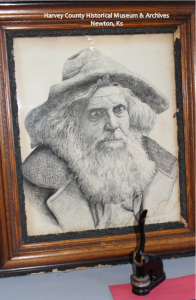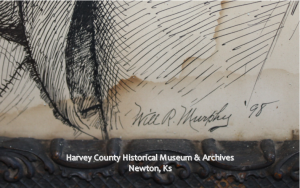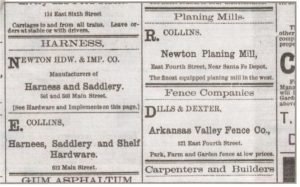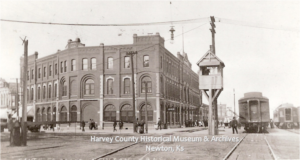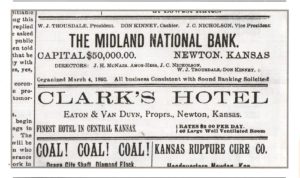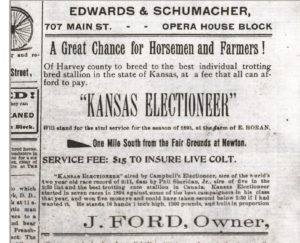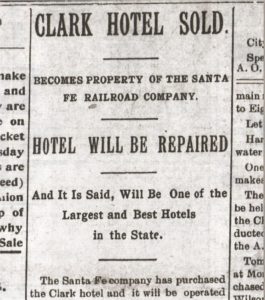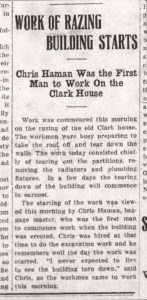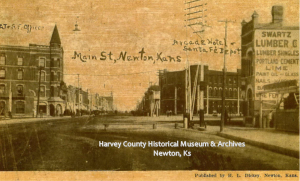by Kristine Schmucker, HCHM Curator
Several months ago, we published Museum Mystery Man and noted that the identity of the man in the drawing was unknown.
At that time the only clue to the identity of the man was that it was drawn by Will R. Murphy in 1898.
Recently another clue came to light. A descendant of Will R. Murphy called HCHM. His family has another copy of the pen and ink drawing exactly like the museum’s. Included with their drawing is the name “ol Hoss Collins.“
There are two men with the last name of Collins in the Newton City Directories in the late 1880s through 1910: Edgar Collins and Robert Collins. Both came to Harvey County in the 1870s and were respected businessmen.
Who were these two men?
Edgar Collins: “An Enviable Trade“
Edgar Collins was born in Cook County Illinois in 1852. By the age of 9 both his parents had died. He was sent to Kansas to live with the O’Brien family in Wathena, Ks. He apprenticed as a harness maker.
At the age of 19, he came to Newton and entered into the harness business. He lived and worked in the Newton, Wichita area for the rest of his life. In addition to the harness business, he engaged in real estate and other business ventures. In 1877, he married Mary M. ‘Mollie’ Stiles and they had one son who died in infancy, and two daughters. The family lived at 818 Oak, and Collins maintained a harness shop at 612 N. Main, Newton.
Mollie died in 1893. In January 1904, Collins married Viola Spore and the couple had two children.
The obituary in the Evening Kansan Republican described E. Collins as
“one of the highly respected citizens of the town. He was admired both in Wichita and Newton for his business acumen and his honest and fairness in dealing with others, at the same time making conservative and level headed decisions.”
Given his occupation as harness maker, the description of ‘ol Hoss Collins’ makes sense. With a Newton business, he no doubt would have known W.R. Murphy.
Another possibility . . .
Robert Collins: “Faithful & Efficient Employee”
Robert Collins was born in Belfast, Ireland in September 1842. He was the sixth of ten children and his father was a Presbyterian minister. At the age of 16, Collins left Ireland for the United States. He lived various places including Crockett, TX, and later Philadelphia. While in Philadelphia, he learned the trade of carpentry and building. At the outbreak of the Civil War, he joined Co. H, 6th Regiment Pennsylvania Cavalry. He participated “in all the battles and campaigns in the army of the Potomac, from the first Bull Run to Gettysburg” and was wounded at Gettysburg.
After the war, Collins spent time in Oklahoma and Kansas. When he first arrived in Newton he established a carpentry business at 120 N. Main. He married Jane Powers in 1878 and their residence was at 325 E. 2nd, Newton. The couple had five children.
In 1886, Collins built a two story brick building on E 4th to meet the need for a planing mill or “sash and door factory.” He employed fifteen men in 1887. His building projects in Newton were “monuments to his energy and ability.” One example was the Swensen’s Building, a three story brick structure at 6th and Main, Newton, completed in 1887.
By 1902, Collins was working for the Santa Fe Railroad on bridges and buildings. In his work Collins oversaw building projects for the Santa Fe Railroad including the Santa Fe hospital in LaJunta, Co, the Arcade Building in Newton, and the crossing gates and watch tower at Florence, Ks.
In 1906, Collins was promoted to “building inspector on the eastern grand division. . . well deserved . . . for no more faithful or efficient employee can be found among the big army of Santa Fe employees.”
Robert Collins was active in the community and he served as councilman for the Third Ward, Newton, for several years. He was involved in several community organizations including the Masons. Collins retired in 1908 from his work with the Santa Fe. He died 5 May 1909.
Sources
-
Edgar Collins (1852-1930)
- Newton Daily Republican: 3 August 1886, 16 February 1887, 16 June 1887, 22 June 1887, 23 June 1887, 15 July 1887, 4 March 1891, 18 February 1893, 20 February 1893.
- Evening Kansan Republican: 20 October 1930.
- Newton City Directories: 1885, 1887, 1902, 1905.
- https://hchm.org/wp-content/uploads/2013/12/Marriage_List_Groom.pdf
- Old Settler’s Card File, HCHM Archives.
-
Robert Collins (1842-1909)
- Newton Daily Republican: 26 May 1887, 24 July 1887, 7 August 1887.
- Evening Kansan Republican: 12 September 1899, 4 April 1902, 24 August 1906, 5 May 1909, 6 May 1909.
- Newton City Directories: 1885, 1887, 1902, 1905.
- Old Settler’s Card File, HCHM Archives.
- Wittenberg, Eric J. Rush’s Lancers: The Sixth Pennsylvania Calvary in the Civil War, Appendix, Westholme Publishing, 2007.
Both men were buried in Greenwood Cemetery, Newton, Kansas.


